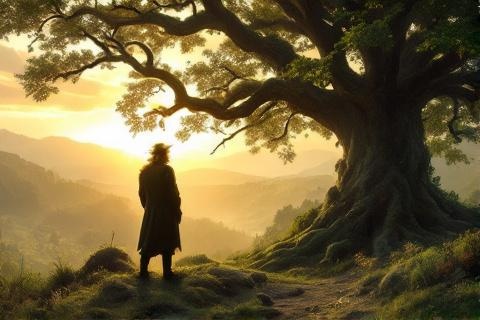
Tom Bombadil: Master of the Old Forest
The Enigma of Middle-earth
The Mystery of Tom Bombadil's Nature

Tom Bombadil stands as one of the most ancient beings in
Middle-earth, existing before the first Dark Lord
Morgoth came into the world. In his own words to the
hobbits, he declares himself the Eldest and the Master,
remembering the first raindrop and the first acorn. He witnessed the arrival of
the first Dark Lord and saw the first trees grow, existing even before the elves
awakened in Middle-earth. His origins remain shrouded in mystery, as he appears
in no creation stories or ancient tales of the Valar.
Among all beings in Middle-earth, Tom Bombadil alone showed complete immunity to
the One Ring's corrupting influence. When Frodo handed him
the Ring, Tom treated it as a mere trinket, putting it on without becoming
invisible and even making it disappear with a playful trick. The Ring held no
power over him, and he could see Frodo even when the hobbit wore it. This unique
immunity sets Tom apart from even the most powerful beings in Middle-earth,
including the Wizards and the High Elves.
Gandalf's words about Tom Bombadil at the Council of
Elrond hint at his mysterious nature without
revealing it. The wizard describes Tom as the oldest and most independent being
in Middle-earth, calling him 'Master of wood, water, and hill.' Gandalf's
careful choice of words suggests he knows more about Tom's true identity than he
reveals, yet he speaks of him with both respect and wonderment. The wizard's
cryptic references have led to countless debates about whether Tom might be a
Vala, a Maia, or something else entirely unique in Tolkien's
mythology.
Master of the Old Forest
Within the Old Forest, Tom Bombadil exercises complete authority over the
ancient and often malevolent trees. His dominion extends throughout this
mysterious woodland, where trees move of their own accord and harbor old grudges
against those who cut their kin. Tom's authority manifests not through force but
through an inherent mastery that the trees recognize and respect, allowing him
to traverse the dangerous paths of the forest without fear.
Tom's relationship with Old Man Willow reveals much about his power in the
forest. Despite the ancient tree's malevolent nature and its hatred for walking
things, Tom maintains authority over it through his songs and commands. When the
great willow tree traps Merry and Pippin in its trunk and tries to drown Frodo,
Tom's simple commands make the tree release its victims. His relationship with
Old Man Willow demonstrates both his power and his role as a mediator between
the natural world and other beings.
The boundaries of Tom's domain and power are clearly defined within the story.
His realm extends from the Old Forest to the Barrow-downs, and within these
borders, his power remains absolute. However, he never ventures beyond these
boundaries, suggesting both his power and his limitations. The hobbits learn
that he is the Master of his domain, but his mastery does not extend beyond his
chosen borders, reflecting a self-imposed limitation that defines his role in
Middle-earth.
Songs and Powers

Tom Bombadil's singing represents a fundamental power in Middle-earth, different
from the magic of Elves or Wizards. His songs carry real power, commanding the
natural world and shaping reality around him. When he sings, trees bend to his
will, dark creatures flee, and the very essence of things seems to respond to
his voice. His songs are not mere entertainment but manifestations of his
authority over his domain, showing a deep connection to the music of creation
itself.
Through his mastery of rhyme and verse, Tom demonstrates an ancient form of
power that predates the structured magic of later ages. His seemingly
nonsensical verses contain power that affects the physical world, whether
calming angry trees or banishing evil spirits from the barrow-downs. Each rhyme
and song serves a specific purpose, showing how Tom's connection to nature works
through the power of his voice and the rhythm of his words.
Tom's ability to name things reveals his deep understanding of their true
nature. In Tolkien's world, names hold great power, and Tom's naming abilities
show his insight into the essence of things. He knows the true names of all
creatures in his realm, and his naming of things represents a form of mastery
over them. This power connects to the larger theme in Tolkien's works about the
significance of names and naming, reflecting an ancient power that stems from
understanding the true nature of things.
Life with Goldberry

Goldberry, known as the River-woman's daughter, represents another mysterious
figure in Tom's realm. Her nature remains somewhat ambiguous in Tolkien's works,
but she clearly possesses a deep connection to the waters of the Old Forest. She
shares some of Tom's power over the natural world, particularly concerning the
rivers and waters of their domain. Her presence adds grace and beauty to their
home, complementing Tom's earthy nature with her connection to water.
Life in Tom and Goldberry's house offers a glimpse into an existence untouched
by the troubles of the wider world. Their home serves as a sanctuary where time
seems to flow differently, filled with songs, good food, and peaceful rest.
Visitors experience a sense of timelessness and safety within their walls, where
even the greatest worries of the outside world seem distant. Their domestic life
represents a harmony between nature and civilization that exists nowhere else in
Middle-earth.
The annual ritual of collecting water-lilies represents a significant tradition
in Tom and Goldberry's relationship. Each summer, Tom travels to gather these
flowers for Goldberry, continuing a tradition that began with their first
meeting. This yearly custom demonstrates their connection to the natural cycles
of the world and their commitment to maintaining ancient practices. The ritual
holds special significance as it commemorates their first encounter and
symbolizes the renewal of their bond with each passing year.
Rescuer of the Hobbits
Tom's rescue of Frodo and his companions from Old Man Willow demonstrates his
protective role in the Old Forest. When the hobbits find themselves in mortal
danger from the malevolent tree, Tom appears singing and commands the ancient
willow to release them. His intervention shows both his power over the forest's
dangers and his willingness to help travelers in need. The rescue serves as the
hobbits' first experience with Tom's authority over the natural world.
During their stay at Tom's house, the hobbits receive protection from both
physical and supernatural threats. His home provides a sanctuary where no evil
can enter, allowing the travelers to rest safely and recover from their ordeal
in the forest. Tom shares knowledge about the dangers they face and provides
them with tools for their journey, including ancient blades from the
Barrow-downs that later prove crucial in their quest.
Tom's assistance against the Barrow-wights reveals the extent of his power
against supernatural evil. When the hobbits become trapped in the barrows, Tom's
songs and commands banish the ancient spirits and break their spells. His power
proves effective against these ancient evils, demonstrating his authority
extends beyond the natural world to include mastery over supernatural threats
within his domain. He not only rescues the hobbits but also ensures they emerge
stronger and better equipped for their journey.
Tom's Role in the War of the Ring
The Council of Elrond's discussion about Tom Bombadil reveals how the wise of
Middle-earth viewed this mysterious figure. When Elrond and the council members
consider various options for the One Ring, they acknowledge Tom's power but also
recognize the limitations of his involvement. The council's debate shows their
understanding that while Tom might be powerful enough to protect the Ring, his
nature makes him an unsuitable guardian for it.
The decision not to leave the Ring with Tom stems from their understanding of
his fundamental nature. The council realizes that Tom would likely forget about
or misplace the Ring, not out of carelessness but because he exists outside the
Ring's power and significance. They understand that Tom's immunity to the Ring
also means he cannot appreciate its importance to the fate of Middle-earth,
making him an unreliable guardian despite his power.
Tom's non-involvement in the War of the Ring reflects his nature as a being
apart from the great conflicts of Middle-earth. His decision to remain within
his own borders during the growing darkness shows his commitment to his role as
guardian of his small realm. While some might see this as a failure to help in
times of need, it actually represents his understanding and acceptance of his
place in the greater order of things.
Legacy and Significance

Tom Bombadil represents the gradually disappearing natural world of
Middle-earth, standing as a guardian of the old ways and ancient memories. His
presence in the story serves as a reminder of what once was and what is slowly
fading from the world. As the age of Men approaches and the time of
Elves and magic wanes, Tom remains as a testament to an earlier, more pristine
age of Middle-earth.
As Middle-earth's last mystery, Tom Bombadil embodies the idea that some things
in the world should remain unexplained. His very existence challenges the desire
to categorize and explain everything in Tolkien's mythology. While other
characters and elements in the story can be classified and understood, Tom
remains deliberately enigmatic, representing the importance of mystery in a
world becoming increasingly ordered and explained.
J.R.R. Tolkien's own statements about Tom Bombadil provide insight into the
character's purpose in the story. In his letters, Tolkien explains that Tom
represents the spirit of the vanishing Oxford and Berkshire countryside,
embodying a particular attitude toward things. The author deliberately left
Tom's nature ambiguous, stating that some mysteries should remain in any
mythology. Tolkien viewed Tom as an important element in his story, representing
the need for pure naturalistic science and wonder in the world.
